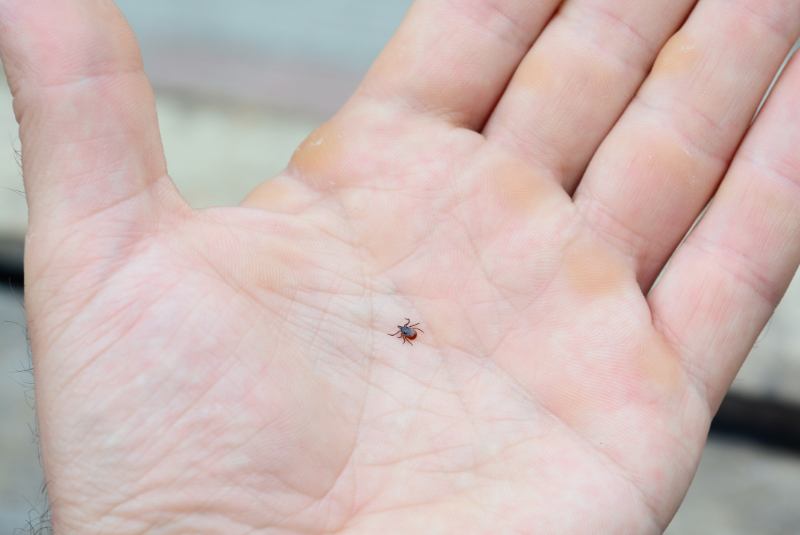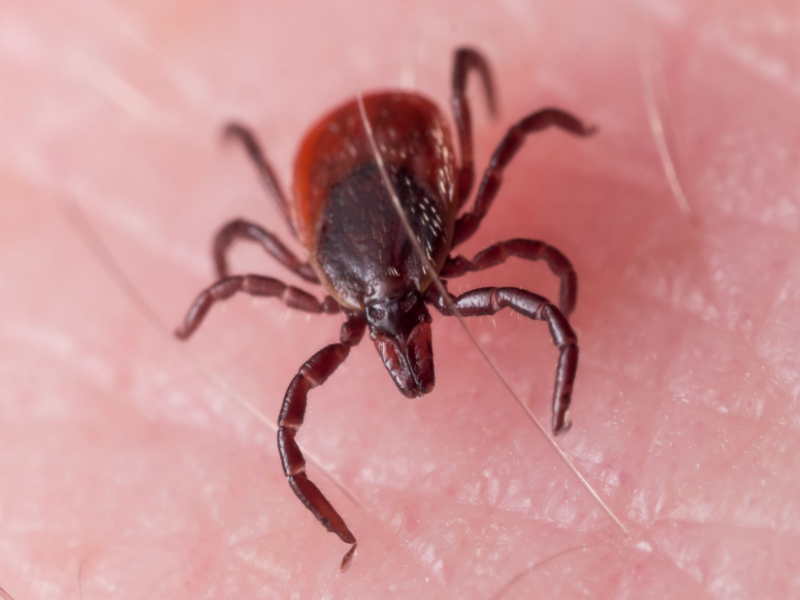The incubation period for Lyme disease is 3-30 days. Early signs include Erythema migrans (EM), a red ring or homogeneous rash at the site of the tick bite that expands gradually over several days to more than five centimeters in diameter. “There is a central clearing that may develop as the rash expands, resulting in a “target” or “bull’s eye” appearance. The rash may be warm to the touch but is rarely itchy or painful (CDC, 2022; IDSA, 2020). In the early stages, a client may experience a high fever, chills, fatigue, headache, malaise, myalgia, and arthralgia. Lymphedema is common. Untreated Lyme disease will progress to disseminated disease in about 60% of clients. Most manifestations will appear in the first few weeks to months of infection but may be delayed (CDC, 2022; IDSA, 2020).
Neurological manifestations are also found, including cranial neuritis, most commonly Bell’s palsy (facial paralysis that can be bilateral), lymphocytic meningitis, painful radiculoneuritis involving one or more dermatomes, painful peripheral motor and sensory neuropathy (mononeuritis multiplex) and in rare instances, intracranial hypertension (CDC, 2022; IDSA, 2020).
Cardia manifestations commonly found include Lyme carditis resulting in conduction abnormalities (e.g., atrioventricular node block; myopericarditis) that are rarely fatal. Rheumatological manifestations include oligoarticular arthritis (transient, migratory arthritis and effusion in one or multiple joints) and Baker’s cyst. Migratory pain in tendons, bursae, muscles, and bones is common as well (CDC, 2022; IDSA, 2020; Steere et al, 1977).
RMSF is one of the deadliest of all tickborne illness in the United States. It is a bacterial infection that presents with the common flu-like symptoms of fever, headache, nausea, vomiting, stomach pain, muscle pain, and rash. The rash usually occurs within 48-72 hours after infection. The rash is non-descript but, in some cases, will appear as red splotches or pinpoint dots all over the body. Severe forms of RMSF can result in amputation of limbs, hearing loss, paralysis, mental disability, and or death (Benjamin et al., 2021; CDC, 2023; CDC, 2019; ISDA, 2022).
The incubation period for both Anaplasmosis and Ehrlichiosis is between 5 and 14 days. Signs and symptoms include fever, chills, rigors, severe headache, malaise, myalgia, and gastrointestinal symptoms (nausea, vomiting, diarrhea, anorexia). A rash is uncommon in Anaplasmosis infection and occurs in less than ten percent of those infected (CDC, 2022). It is more common in people with the E. chaffeensis ehrlichiosis (CDC, 2023). If a rash develops, it often appears as red splotches or pinpoint dots all over the body.
All forms of Tularemia present with a fever that can go as high as 104 degrees Fahrenheit. In ulceroglandular tularemia, swelling of lymph glands in the armpit or groin area is common, and a skin ulcer will develop where the tick bite occurred. This is the most common form of tularemia. Typhoidal and pneumonic are more serious forms of tularemia and usually develop when other forms of tularemia (e.g., ulceroglandular or glandular) are unrecognized or untreated. The incubation period typically ranges from one to 14 days (CDC, 2023).
Babesiosis is a Parasitic disease. This malaria-like parasite infects red blood cells and causes flu-like symptoms. Older populations and those who are immunocompromised can have more severe symptoms that can be fatal (Krause et al., 2020; ISDA, 2022).
Powassan Virus Disease, like all other tickborne diseases, initial symptoms mimic the flu and are initially present at the onset of illness. Powassan virus can progress to more severe illness such as encephalitis, seizures, and death. Half of all people who experience severe illness have long-term complications, including reoccurring headaches, loss of muscle mass, and memory issues. One in ten people with severe disease die (CDC, 2023).
The defining symptom of Colorado Tick Fever is a biphasic fever, meaning that the infected client will have several days of high fever, a respite for a few days, and then a reoccurring fever. A life-threatening illness is rare for Colorado Tick Fever, and the illness usually resolves without complication (Benjamin et al., 2021).
Bourbon Virus Disease is named after Bourbon County, Kansas, where the first man who carried this disease resided and was first diagnosed in 2014. Previously, the virus was only found in Africa, southern Europe, and Central Asia. Tick bites occur approximately two weeks before the onset of symptoms, and like other viruses, signs and symptoms mimic the flu (e.g., fever, fatigue, arthralgia, myalgia, nausea, diarrhea, etc.) (Benjamin et al., 2021; CDC, 2022; CDC, 2023).











